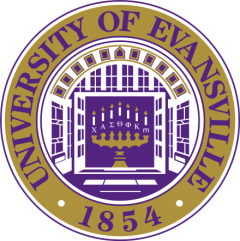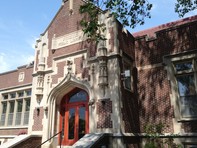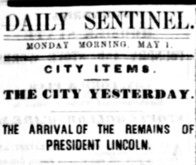https://www.vanderburghsheriff.com/jail-recent-booking-records.aspx
Commentary: Hard Work On The Front Lines
Commentary: Hard Work On The Front Lines
By John Krull
TheStatehouseFile.com
INDIANAPOLIS—The woman sighed and apologized.
She was checking me in for my first vaccine shot. We were at a converted big box store in an almost abandoned strip mall on the west side of Indianapolis.


It was early afternoon. There was a long line of people ahead of me and a long line behind me.
The woman at the makeshift desk was frustrated. Her computer had frozen. She said she was sorry.
I told her it was okay.
There were a lot of people in line waiting to get their shots, I said. That was a lot of work for her and her colleagues and for whatever computer system they were using.
“There also are a lot of people trying to register,†she said, weariness soaking her voice. “That’s slowing the system down.â€
She was about my age—well beyond her first spring.
I mentioned the state just had announced that a new age group—45 to 49—could sign up for shots.
“They’re letting the youngsters in now,†I said.
She smiled, then chuckled.
“Yeah,†she said and handed me my forms.
I told her how much I appreciated the work she and her colleagues were doing. I said I knew it had to exhausting.
But it was essential.
Is essential.
She smiled again and thanked me.
Then pointed me to the line where I should wait for my shot.
I looked at the people gathered to get their vaccines.
Many were like me, in overall good health and thus easy to manage in a process that involved waiting in line and following instructions.
But there were others, too.
A guy a few stops in front of me used a walker. He wore a faded cap that touted his military service in worn and now indecipherable symbols.
The staff at the vaccination site helped him through the line. Whenever they told him what he had to do or to which station he had to move next, he said, “What?â€
They repeated what they’d said, a little louder but without taking any of the kindness or courtesy out of their tones.
When I sat down at the nurse’s station to get my shot, I looked at the secured container holding the used and discarded needles.
I asked the nurse if those were all from that day.
“Just from the last couple hours,†she said.
Then, even though she must have been dead on her feet, she went through the drill. She asked me about allergies or other reactions that might make taking the vaccine hazardous to my health.
After she had gone through the checklist with diligent patience, she swabbed my left arm with alcohol and gave me my shot.
As I thanked her, she removed the needle and put it in the storage bin.
One more of how many? A hundred? More than that? And of how many such storage bins?
She instructed me to go sign up for my next shot and then wait for 10 minutes to make sure I had no adverse reactions before leaving.
As I sat waiting to be released, I looked around the big room.
There were dozens of people who, like me, waited to be released. Dozens and dozens and dozens more either were getting their shots or were in line waiting to get a shot.
And all around were public health workers scrambling, ushering, helping with seemingly infinite patience and unfailing kindness.
Over the past year, we often have touted the courage of our healthcare workers—as we should.
But we also ought to acknowledge their sheer professionalism and determination.
It is—it must be—hard, mind-numbing labor to do the same thing over and over. It also must be difficult to deal with people who are often frightened, confused or just plain frustrated.
The people working in this building must be more sick and tired of the pandemic than anyone.
But that hasn’t stopped them from doing their jobs and treating their fellow human beings with consideration and respect.
As I left, I took one last look at the big building and all those in it.
I felt good about getting my shot.
And even better who had given it to me.
FOOTNOTE: John Krull is director of Franklin College’s Pulliam School of Journalism and publisher of TheStatehouseFile.com, a news website powered by Franklin College journalism students.
COMMENTARY: JOE GRIES IS SERVING US WELL UNDER PRESSURE
THANKS TO JOE GRIES FOR JOB WELL DONE
Joe Gries has worked within the Vanderburgh County government for over 20 years. His governmental career started in the Knight Township Assessor’s office where he valued property and ended up as the Real Estate Supervisor for the 2002 township wide reassessment.
In 2005 Joe became the Chief Deputy Auditor supervising the county’s finances and payroll departments. Joe was elected Vanderburgh County Auditor in 2010 and 2014. The County Auditor is the chief financial officer of the county and works closely with the County Council and Commissioners as well as all county elected officials preparing the yearly county budget.
In 2016 Joe joined the Health Department as the Administrator and has worked closely with our Health Officer, Board of Health, and staff to continue to improve the public health services provided to our community.
The City County Observer staff appreciates the way that Mr. Gries has handle every aspect of the COVID-19 pandemic. Â We consider his handling of the COVID-19 to be his crowning achievement in his 20 years in working in the pubic sector.
If you happened to see Mr. Gries sometime this coming weeks please thank him for a job well done during an extremely stressful and challenging time.
FOOTNOTE: We are also very appreciative with how the fine staff at the Vanderburgh County Health Department have also perform during the pandemic.
HOOSIERS AGES 40 AND OLDER TO BE ELIGIBLE FOR COVID-19 VACCINE STARTING MONDAY
Hoosiers ages 40 and older will be eligible to receive a free COVID-19 vaccine starting Monday, the Indiana Department of Health announced today. This expansion of eligibility to include those ages 40 to 44 will make the vaccine available to more than 400,000 additional Hoosiers.
Additional groups will be added as more vaccine becomes available.
Vaccine appointments for this newly eligible population will be available starting Monday and will extend over the next several weeks to align with expected vaccine deliveries to the state. Individuals seeking an earlier appointment are encouraged to look at openings in surrounding counties.
To schedule a vaccine, visit https://ourshot.in.gov and select a location from one of more than 450 clinics around the state. Hoosiers who do not have a computer or cell phone or those who need assistance scheduling an appointment can call 211 or contact one of Indiana’s Area Agencies on Aging or AARP. Nearly 70 libraries around the state also are helping Hoosiers schedule their appointments.
Vaccination clinics that are part of the federal vaccine program, including those at Meijer and Kroger, appear on the clinic map at https://ourshot.in.gov but are scheduled through those retailers’ platforms, not through the state centralized system.
Senator Braun, Senator Introduce ‘Consider Teachers Act
Senator Braun, Senator Sinema, Congresswoman Eleanor Holmes Norton Â
Senator Mike Braun, Senator Kyrsten Sinema, and Congresswoman Eleanor Holmes Norton have reintroduced a bill aimed at fixing a broken system burdening teachers with unfair loans: the Consider Teachers Act of 2021.
The TEACH Grant program provides grant assistance to students who serve four years as a full time teacher in high-need, often underserved communities. However, often due to basic clerical mistakes, thousands of teachers have found their grants converted into loans that must be paid back with interest. The Consider Teachers Act aims to fix this broken system permanently.
“The TEACH grant is an important program to incentivize teachers to serve in neglected communities, but 12 years of poor government management has turned these grants into groans for thousands of teachers,” said Senator Braun. “To show our appreciation for America’s great teachers, let’s get off the sidelines and fix this broken system once and for all.”
“Arizona teachers use TEACH grants to serve Arizona families in low-income schools. The government made a promise to those teachers, and our commonsense bill ensures the government honors its obligation,” said Senator Sinema.
“I am pleased to join Senators Braun and Sinema in introducing the Consider Teachers Act of 2021, which will reform the Teach Grant program that is unfairly converting many teachers’ grants to loans. Currently, many teachers are finding their grants converted to loan debt because of small administrative errors that might be unavoidable due to the coronavirus crisis. This bill will correct the administrative process and extend the period teachers have to fulfill their service requirements by three years for those who were affected by the coronavirus crisis,†said Congresswoman Eleanor Holmes Norton.
BACKGROUND:Â
In 2007, the federal government created the TEACH Grant, providing grant assistance to students who serve four years as a full time teacher in a high-need field. Under program terms, if service requirements are not met, grants are converted into loan obligations. While the program was well- intentioned, poor program administration has resulted in teachers unfairly having grant dollars converted into loans—prompting many to refer to the converted grants as “groans.†The Consider Teachers Act addresses these challenges that are thwarting the program’s intent.
According to the Office of Management and Budget, the majority of TEACH Grants, 66%, are converted into Federal Direct Unsubsidized Stafford Loans which must be paid back with interest. Once converted, a loan cannot revert back to grant. 21,000 teachers have completed the program without a conversion, but 94,000 recipients have had their grants converted to loans. Small paperwork issues often triggered the conversions. For example, if teachers sent in their annual form one day late, or had other problems, such
UE Announces Return to Regular Operations for Fall 2021 Semester
The University of Evansville (UE) will return to normal operations and offer most courses in-person for the Fall 2021 semester, offering online and hybrid courses when appropriate. The plans were developed in accordance with COVID-19 trends at the local, state, and national levels, and recognize the increasing availability of vaccines and reduced rates of transmission.
“Since the pandemic arrived last year, we have been looking forward to the day when we can safely return to normal,” said Christopher M. Pietruszkiewicz, University of Evansville president. “Even if there are precautions in place in the fall, we have every intention of providing the complete in-person college experience that is the foundation of our education at UE.”
Pietruszkiewicz also noted UE’s success in preventing the spread of COVID-19 on campus. For the 2020-2021 academic year, UE’s Coronavirus Task Force implemented several measures to protect the campus community. This included moving select classes to an online or hybrid format and reducing classroom density. As the task force continues to navigate the pandemic and adjust plans accordingly, the University expects a full return to regular in-person course offerings and activities for the fall.
“Our entire campus community has been very dedicated to protecting those around them by following the protocols in place,” Pietruszkiewicz said. “It is thanks to the support of each member that we have made it this far and can confidently look ahead to the fall.”
As safety remains a top priority, UE will continue to follow guidelines at the local, state, and national levels. Following direction from the CDC, some health and safety precautions may be in place for the campus, and it is certainly possible that external conditions could alter these plans.
The fall semester will follow a normal class schedule and is slated to begin Wednesday, August 25.
Helping Veterans Shift Skills To Civilian Workforce
This approach is centered on the individual defining his or her own success. The Catalyst works with a veteran, whether they are looking for a high-paying career, wanting to start a non-profit or hoping to complete a degree.
The Catalyst Program spans seven weeks and combines civilian recruiting with in-class undergraduate and graduate education, mentoring, networking and job shadowing. Veterans learn how to translate their experience from the military and combine it with their passions.
Apply today for one of the upcoming cohorts. The next available program starts April 13. Classes are currently offered both in-person and virtually.
A Carnegie Library for Vincennes
March 21 – March 27The Week in Indiana History |
|||||||||||||||||
“I don’t know if I practiced more than anybody, but I sure practiced enough. I still wondered if somebody, somewhere, was practicing more than me. – – – Larry Bird Did You Know?   Andrew Carnegie was not a Hoosier. He was born in Scotland and lived his life in eastern states. However, the steel magnate left a lasting impression on Indiana. 164 impressions, to be exact. That’s how many public libraries Carnegie gave to Hoosiers.  As a matter of fact, Indiana has more Carnegie libraries than any other state. In the early years of the 20th Century, the Carnegie Corporation provided funds for 1,679 public libraries in towns and cities around the United States.       Ladies’ book clubs, school groups, and civic organizations joined forces across America to apply for Carnegie funds. The building was paid for, but communities were required to provide a suitable tract of land and establish a tax that would generate funds for maintenance of the building once it was constructed.            The first Carnegie Library in Indiana was in Goshen, dedicated in 1903. The last ones were built in Lowell and North Vernon in 1918. During that 15-year span, thousands of Hoosiers were introduced to their own neighborhood libraries. No fee was to be charged for a library card, and Carnegie insisted that books be placed on open shelves so that readers could browse on their own.       Carnegie Libraries were built to stand the test of time. Made of brick, limestone, and marble, they were designed by leading architects. They were constructed in a variety of styles, including Italian Renaissance, Spanish Colonial, Beaux-Arts and Classical Revival.            A survey a few years ago found that 145 Indiana Carnegie Libraries are still standing. Approximately 100 of those are still in use as libraries. Others have been converted into public meeting halls, restaurants, bookstores, and residences.            Andrew Carnegie once said, “A library outranks any other one thing a community can do to benefit its people. It is a never- failing spring in the desert.” ANSWERS: 1. Tulip Poplar tree 2. Wabash River 3. Lake Monroe 4. McCormick’s Creek State Park |
|||||||||||||||||







 1910   The Carnegie Corporation approved a $30,000 grant for the construction of a public library in Vincennes. The offer was increased to $35,000 when a suitable lot was procured at the corner of Seventh and Seminary Streets. Local architect J. B. Bayard designed the structure in the style of Collegiate Gothic Revival. The library was dedicated in 1919 and continues to serve the reading public after more than a century.
1910   The Carnegie Corporation approved a $30,000 grant for the construction of a public library in Vincennes. The offer was increased to $35,000 when a suitable lot was procured at the corner of Seventh and Seminary Streets. Local architect J. B. Bayard designed the structure in the style of Collegiate Gothic Revival. The library was dedicated in 1919 and continues to serve the reading public after more than a century. 1919   A group of farmers got together at the Claypool Hotel in Indianapolis to organize the Indiana Federation of Farmers’ Association. Their goal was to promote farming and agricultural programs and issues. John G. Brown of White County was elected the first president of the organization, along with a 10-member board of directors. Now known as Indiana Farm Bureau, the association serves all 92 counties.
1919   A group of farmers got together at the Claypool Hotel in Indianapolis to organize the Indiana Federation of Farmers’ Association. Their goal was to promote farming and agricultural programs and issues. John G. Brown of White County was elected the first president of the organization, along with a 10-member board of directors. Now known as Indiana Farm Bureau, the association serves all 92 counties.


 1951   Mary Rieman died in Indianapolis at the age of 92.  She was one of the last surviving witnesses to the funeral of Abraham Lincoln at the Indiana Statehouse. At the age of six, she was with her family on April 30, 1865, when the Lincoln funeral train arrived in Indianapolis. She had clear memories of standing in the cold rain with thousands of others as they made their way into the Statehouse rotunda to view the body of the fallen President. Pictured: The headline from the Indianapolis Daily Sentinel for May 1, 1865. Â
1951   Mary Rieman died in Indianapolis at the age of 92.  She was one of the last surviving witnesses to the funeral of Abraham Lincoln at the Indiana Statehouse. At the age of six, she was with her family on April 30, 1865, when the Lincoln funeral train arrived in Indianapolis. She had clear memories of standing in the cold rain with thousands of others as they made their way into the Statehouse rotunda to view the body of the fallen President. Pictured: The headline from the Indianapolis Daily Sentinel for May 1, 1865.  




